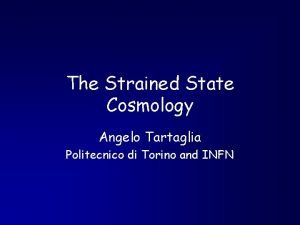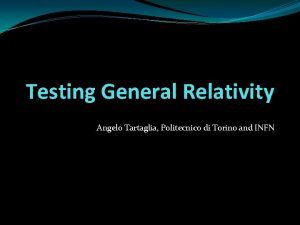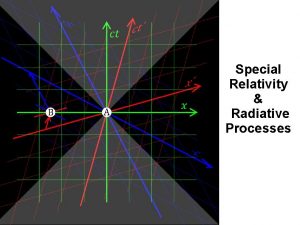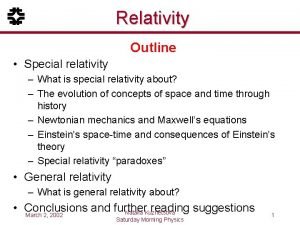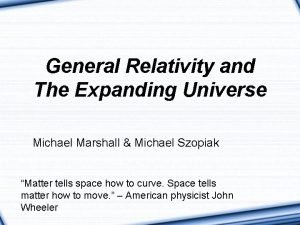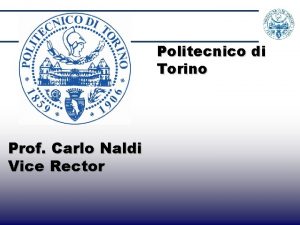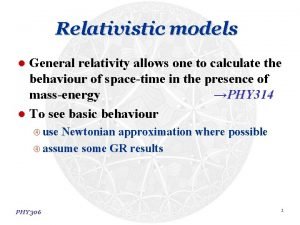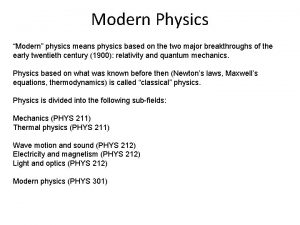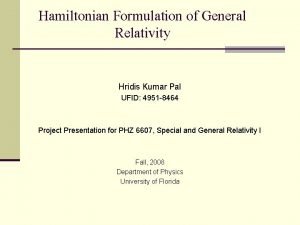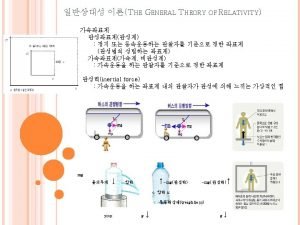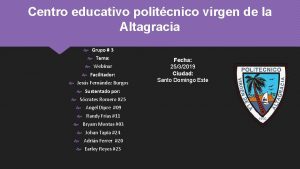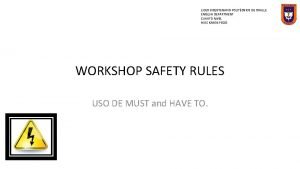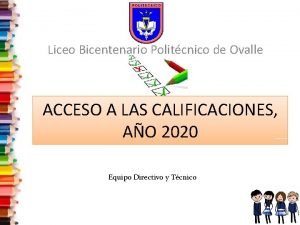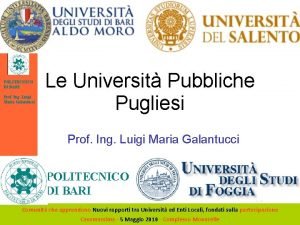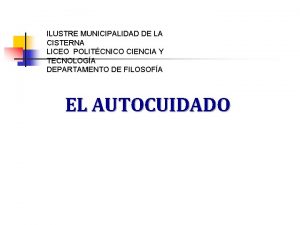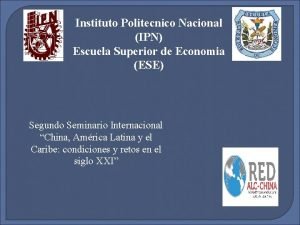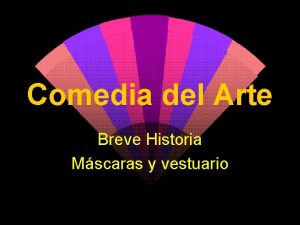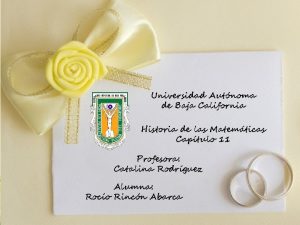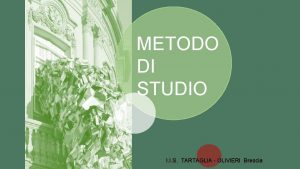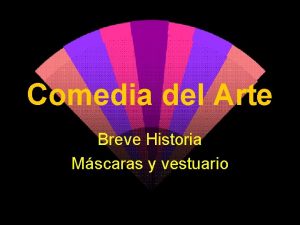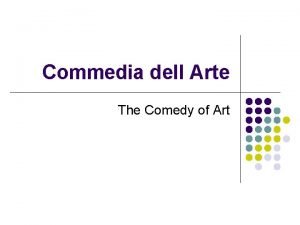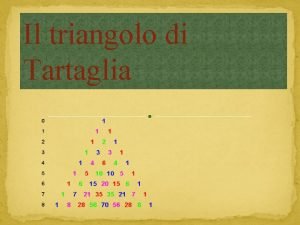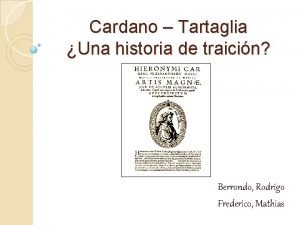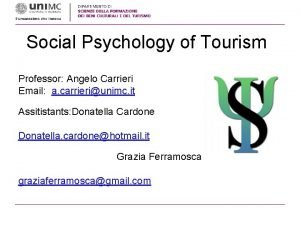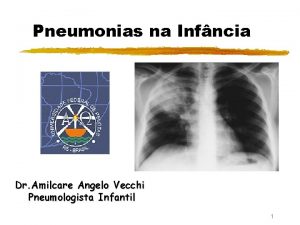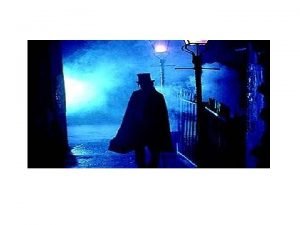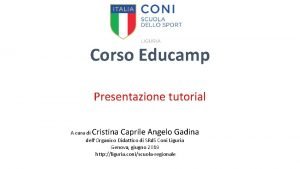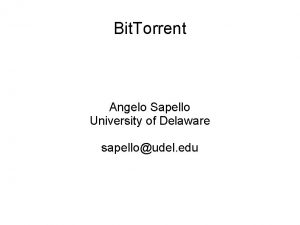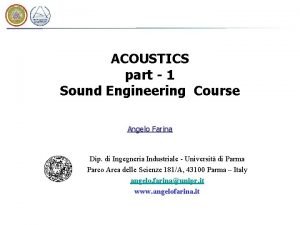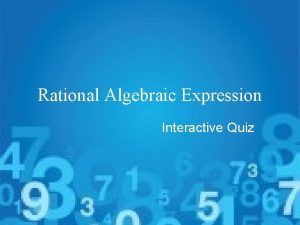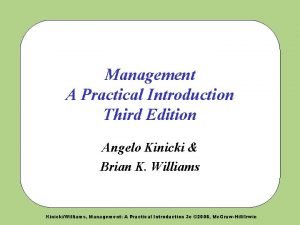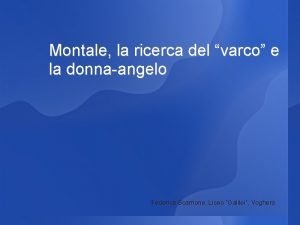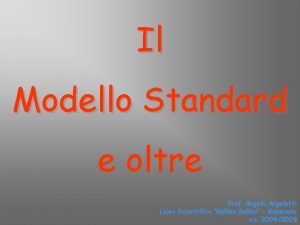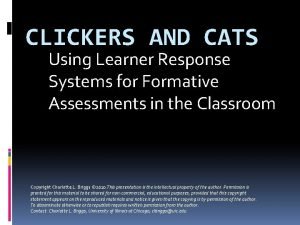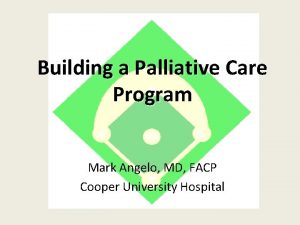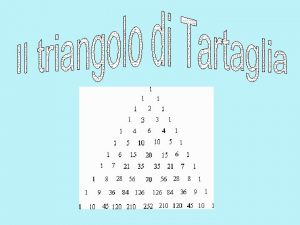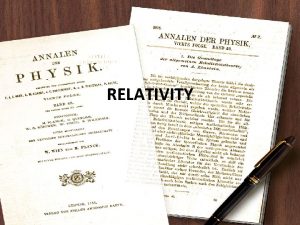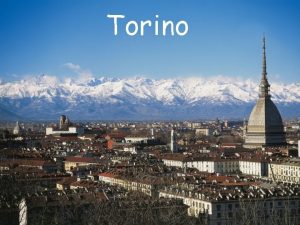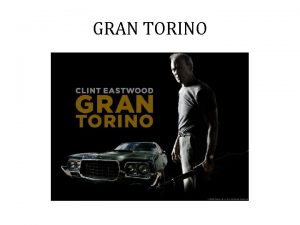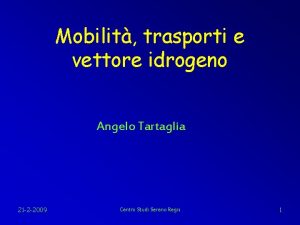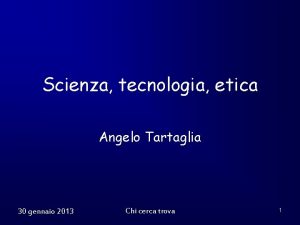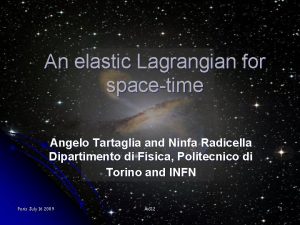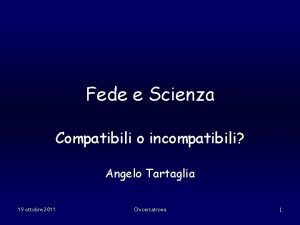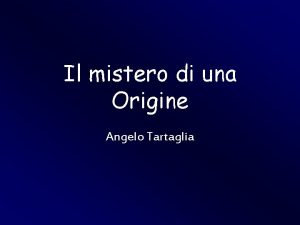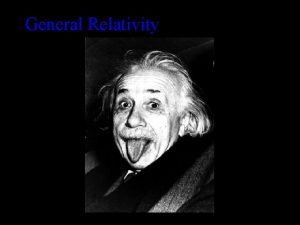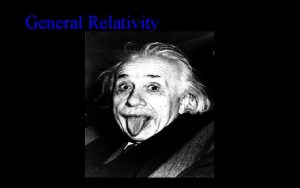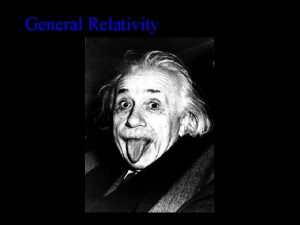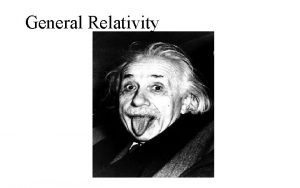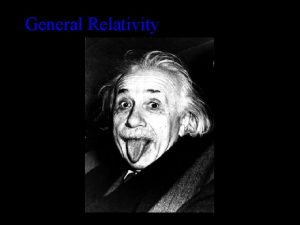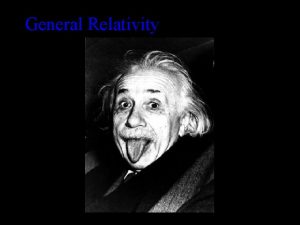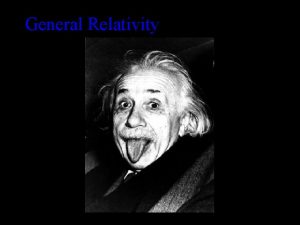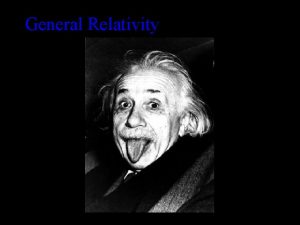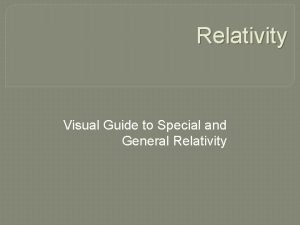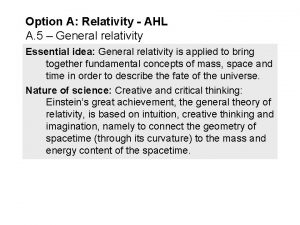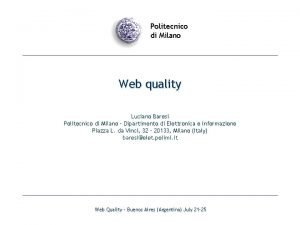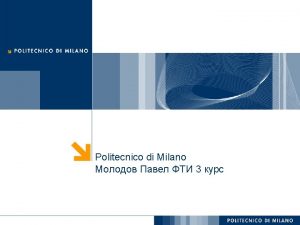Testing General Relativity Angelo Tartaglia Politecnico di Torino


















































- Slides: 50

Testing General Relativity Angelo Tartaglia, Politecnico di Torino and INFN

Subjects Instant General Relativity Historical tests The Equivalence principle Gravitomagnetic effects Gyroscopes Experiments in space Ringlasers Terrestrial experiments: GINGER Atomic interferometry Angelo Tartaglia LNGS - 25/09/2014 2

General Relativity is geometry The universe is made out of two basic ingredients with different properties: space-time and matter/energy Space-time is a four-dimensional Riemannian manifold with Lorentzian signature The presence of matter/energy induces curvature in the manifold The curvature of space-time is what is commonly called the gravitational field The effects of gravity are described by the geometric properties of the curved manifold Angelo Tartaglia LNGS - 25/09/2014 3

The basic tools of GR The relevant physical quantities in GR are expressed by tensors General covariance of the equations of physics A basic ingredient is the (squared) line element (a scalar) of the world-line of a point classical particle: ds 2 = g dx dx Angelo Tartaglia LNGS - 25/09/2014 4

The metric tensor and its descendants The metric tensor g incorporates the geometric properties of the manifold : the connection (not a tensor) g R : the Riemann (curvature) tensor R : the Ricci tensor R: the scalar curvature G : the Einstein tensor Angelo Tartaglia LNGS - 25/09/2014 5

Einstein’s equations The gravitational interaction (the configuration of space-time) is governed by a tensor equation Energy momentum tensor (matter/energy) Einstein tensor (geometry) Angelo Tartaglia Coupling parameter LNGS - 25/09/2014 6

What can we measure? Angelo Tartaglia LNGS - 25/09/2014 7

The exterior Schwarzschild solution From the Einstein equations + spherical symmetry in space and independence from time Schwarzschild ‘polar’ coordinates Angelo Tartaglia LNGS - 25/09/2014 8

A bounded orbit around a central mass Perihelion advance per revolution Angelo Tartaglia LNGS - 25/09/2014 9

Gravitational lensing Angelo Tartaglia LNGS - 25/09/2014 10

Gravitational redshift (Four)-wavevector Observer’s four-velocity Angelo Tartaglia LNGS - 25/09/2014 11

Gravitational redshift from stars and on earth ‘Surface to surface’ Close to the ground Angelo Tartaglia LNGS - 25/09/2014 12

Historical tests Precession of the perihelion of Mercury 1915 Known value: 43’’/Julian century (residual after subtracting various effects from the observed value) Value computed by Einstein: 43’’/Julian century Lensing by the Sun Theoretical value according to GR (1915) ~ 1. 75 ‘’ Observed by Eddington (1919) Gravitational redshift Recognized in the spectral lines of Sirius B (W. S. Adams, 1925) Measured on Earth: Pound and Rebka experiment (1959) Angelo Tartaglia LNGS - 25/09/2014 13

Present challenges (Cosmology) Celestial mechanics Lensing Gravitational waves Equivalence principle Rotation effects (gravitomagnetism) Angelo Tartaglia LNGS - 25/09/2014 14

Extrasolar celestial mechanics Compact binary systems Pulsar plus compact star (White Dwarf, Neutron Star, Black Hole) The Double Pulsar (PSR J 0737 -3029) A few AU interstellar distance Strong gravitational effects Pulsars in globular clusters Sagittarius A* and the surrounding stars Angelo Tartaglia LNGS - 25/09/2014 15

Periapsis precession PSR B 1913+16 (Hulse and Taylor pulsar): 4. 2°/year (compatible with GR) PSR J 0737 -3029 (double pulsar): 16. 9°/year Geodetic (de Sitter) precession PSR J 0737 -3029 B (double pulsar): GR measured (5. 0734± 0. 0007)°/year (4. 77+0. 66 -0. 65)°/year PSR J 1141− 6545 (relativistic precession of the spin of the pulsar) Detected (poor accuracy) A. Possenti and M. Burgay, private communication (2011) Angelo Tartaglia LNGS - 25/09/2014 16

Period decay and GW emission 0. 2% agreement with the quadrupole GW emission rate. PSR B 1913+16 (Hulse and Taylor pulsar), after 33 years 0 f data taking. Angelo Tartaglia LNGS - 25/09/2014 17

An interesting “laboratory”: Sagittarius A* Angelo Tartaglia LNGS - 25/09/2014 18

Gravitational field of a moving mass Global line element in general coordinates (remote inertial observer) Sign depends on the sense of motion Angelo Tartaglia LNGS - 25/09/2014 19

«Acceleration» of a freely falling object (geodetic motion) Christoffel symbols Gravito-electric (→ Newtonian) acceleration ‘Viscous’ term Angelo Tartaglia LNGS - 25/09/2014 20

Gravito-magnetism Stationarity condition: gμν’s do not depend on time Angelo Tartaglia LNGS - 25/09/2014 21

The ‘Lorentz force’ Gravito-magnetic field Angelo Tartaglia LNGS - 25/09/2014 22

Steadily rotating central mass gμν’s independent from both t and φ Weak field Angelo Tartaglia LNGS - 25/09/2014 23

Explicit gravitomagnetic field Dipole Angelo Tartaglia LNGS - 25/09/2014 24

Expected testable effects • Torque on massive gyroscopes • Asymmetric propagation along closed paths (in space) Angelo Tartaglia LNGS - 25/09/2014 25

Relativistic precession of a gyroscope Angular momentum of the gyro Thomas precession de Sitter precession Drag of the inertial frames (Lense-Thirring effect) Angelo Tartaglia LNGS - 25/09/2014 26

Observations and experiments Massive spinning stars in binaries (especially the double pulsar) → results compatible with GR Laser ranging of the orbit of the moon → results compatible with GR Precession of the orbits of terrestrial satellites Precession of a freely falling gyroscope in the gravitational field of the earth Angelo Tartaglia LNGS - 25/09/2014 27

A freely falling gyroscope around the Earth 0 Angular momentum of the Earth Angelo Tartaglia LNGS - 25/09/2014 28

Experiments: Gravity Probe-B C. F. W. Everitt et al. , PRL 106, 221101 (2011) Angelo Tartaglia LNGS - 25/09/2014 29

Results GR geodetic (de Sitter) precession confirmed within ± 0. 28% (previous best result ± 0. 7% from lunar laser ranging) GR frame dragging confirmed within ± 19% (previous best result ± 10% from the laser ranging of the LAGEOS satellites) Final accuracy limited by an unexpected patch effect Angelo Tartaglia LNGS - 25/09/2014 30

The LAGEOS orbit precession N Angelo Tartaglia LNGS - 25/09/2014 31

The experiment Systematic analysis of the reconstructed orbits Good model of the gravitoelectric field of the Earth needed First results (1998): Lense-Thirring verified within 30% 2004 -2010 results, using a model of the gravity of the Earth based on the results of the GRACE experiment: LT verified within 10% I. Ciufolini et al. , Testing Gravitational Physics with Satellite Laser Ranging, to appear on Eur. Phys. J. Plus (2011) Angelo Tartaglia LNGS - 25/09/2014 32

The LARES mission • A compact sphere (36. 4 cm diameter) made of a tungsten alloy; 96 retroflectors. • Almost spherical orbit at a hight of 1450 km. • Purpose: to allow for an LT effect measurement within a few %. • Flying since February 2012 Courtesy of Ignazio Ciufolini Angelo Tartaglia LNGS - 25/09/2014 33

Asymmetric propagation Space path t+ t. A Angelo Tartaglia LNGS - 25/09/2014 t+ ≠ t 34

Times of flight 1 0 Angelo Tartaglia LNGS - 25/09/2014 light 35

Time of flight difference Global coordinated time Proper laboratory time Angelo Tartaglia LNGS - 25/09/2014 36

A ringlaser Resonant loop Mirrors Beat frequency Active cavity Angelo Tartaglia LNGS - 25/09/2014 Length of the loop 37

Where does the beat frequency come from? integer Steady state t+= NT+ t- = NT- periods of the waves Angelo Tartaglia LNGS - 25/09/2014 38

Earth-bound laboratory (lowest approximation order) = angular velocity of the Earth ω = angular velocity of the instrument θ = colatitude of the laboratory Angelo Tartaglia LNGS - 25/09/2014 39

Expected signal ω= Scale factor Area of the loop Sagnac Angelo Tartaglia LNGS - 25/09/2014 40

Orders of magnitude Angelo Tartaglia LNGS - 25/09/2014 41

Actual gyrolasers Commercial fiber optics gyroscope Sensitivity: ~ 10 -7 rad/s/√Herz Angelo Tartaglia LNGS - 25/09/2014 42

Research gyrolasers: G-Pisa Side: 1. 35 m He-Ne laser Granite support Sensitivity: 10 -10 ~ 10 -9 rad/s/√Herz Angelo Tartaglia LNGS - 25/09/2014 43

The Cashmere Cavern near Christchurch (NZ) Various configurations, side up to 20 m A triangular loop, 5 m side will be built Angelo Tartaglia LNGS - 25/09/2014 44

G instrument at the Geodätisches Observatorium Wettzell Absolute sensitivity: ~ 10 -12 rad/s/√Hz Side: 4 m Power: 20 n. W Zerodur support Angelo Tartaglia LNGS - 25/09/2014 45

GINGER: proposed and under development • Tridimensional ring lasers array (three to six or more) • Laser power: ~ 200 n. W • Quality factor of the cavity: Q 3 1012 • Square loop, 6 m in side • Underground location (LNGS) • Purpose: to measure the LT effect with a 1% accuracy (one year integration time) Bosi F. et al. , Phys. Rev. D, vol. 84, p. 122002 -1 -122002 -23 (2011) Angelo Tartaglia LNGS - 25/09/2014 46

Configurations Angelo Tartaglia LNGS - 25/09/2014 47

GR and matter waves interferometry Works like light as rotation sensor Scale factor: Much smaller than with light Cannot be too big Angelo Tartaglia LNGS - 25/09/2014 48

Rotations measured by means of phase shifts Phase difference in a Sagnac-type interference experiment Problems: beam stability; duration of the experiment Angelo Tartaglia LNGS - 25/09/2014 49

Summing up Very good laboratories for GR: Compact binaries Central galactic area Accuracy increasing with time Precision astrometry: Telescopes in space; interferometric techniques Weak rotation effects: Ring lasers; coming accuracy for LT effect: 1% Angelo Tartaglia LNGS - 25/09/2014 50
 Tartaglia triangolo
Tartaglia triangolo Angelo tartaglia politecnico torino
Angelo tartaglia politecnico torino Boost interprocess
Boost interprocess General vs special relativity
General vs special relativity Special vs general relativity
Special vs general relativity Campus politecnico di torino
Campus politecnico di torino Top uic polito
Top uic polito Relativistic acceleration calculator
Relativistic acceleration calculator General vs special relativity
General vs special relativity Hamiltonian formulation of general relativity
Hamiltonian formulation of general relativity 중력파 검출
중력파 검출 Theory of general relativity
Theory of general relativity Sergio ilarri
Sergio ilarri Liceo bicentenario politecnico de ovalle
Liceo bicentenario politecnico de ovalle Ovalle edufacil
Ovalle edufacil Politecnico di torni
Politecnico di torni Luigi maria galantucci
Luigi maria galantucci Liceo politecnico ciencia y tecnologia
Liceo politecnico ciencia y tecnologia Escuela superior de economía
Escuela superior de economía Cardano and tartaglia
Cardano and tartaglia Pantalone commedia dell arte
Pantalone commedia dell arte Antonio maria fior
Antonio maria fior Tartaglia olivieri
Tartaglia olivieri Comedia del arte vestuario
Comedia del arte vestuario What is stock character
What is stock character Triangolo di tartaglia storia
Triangolo di tartaglia storia Niccolò tartaglia triangolo
Niccolò tartaglia triangolo Angelo carrieri
Angelo carrieri San angelo panhellenic
San angelo panhellenic Dr amilcare
Dr amilcare Megan kosirog md
Megan kosirog md Clara neal shawcross
Clara neal shawcross What is the general profile for a serial killer?
What is the general profile for a serial killer? Angelo gadina
Angelo gadina Angelo corallo unisalento
Angelo corallo unisalento Angelo mario venditti
Angelo mario venditti Adam d'angelo
Adam d'angelo San angelo panhellenic
San angelo panhellenic Angelo state university tuition per semester
Angelo state university tuition per semester Sally d'angelo torrent
Sally d'angelo torrent Angelo farina
Angelo farina Angelo can complete his school project in x hours
Angelo can complete his school project in x hours Angelo voulgaris
Angelo voulgaris Kinicki management a practical introduction
Kinicki management a practical introduction Sargenti sealer composition
Sargenti sealer composition Dr angelo fynn
Dr angelo fynn Il varco per montale
Il varco per montale Dr maya angelo
Dr maya angelo Angelo angeletti
Angelo angeletti Learner response systems
Learner response systems Mark angelo md
Mark angelo md
